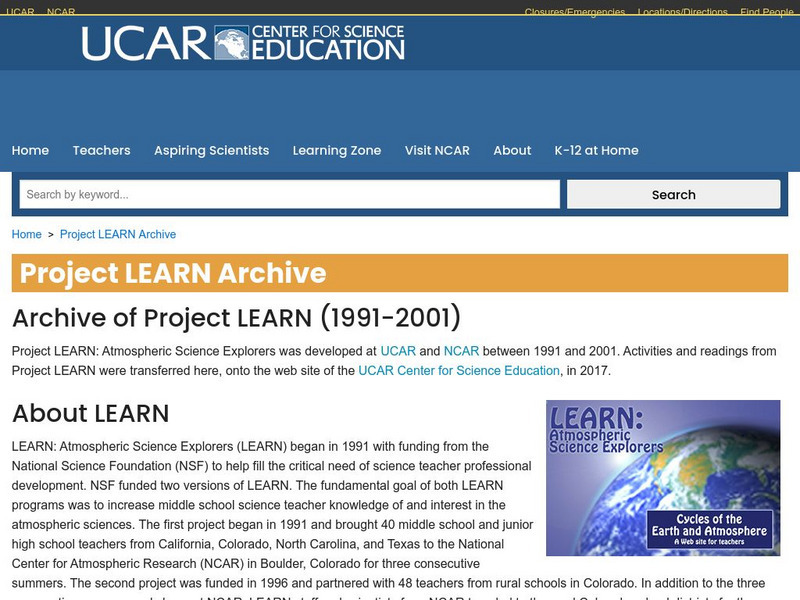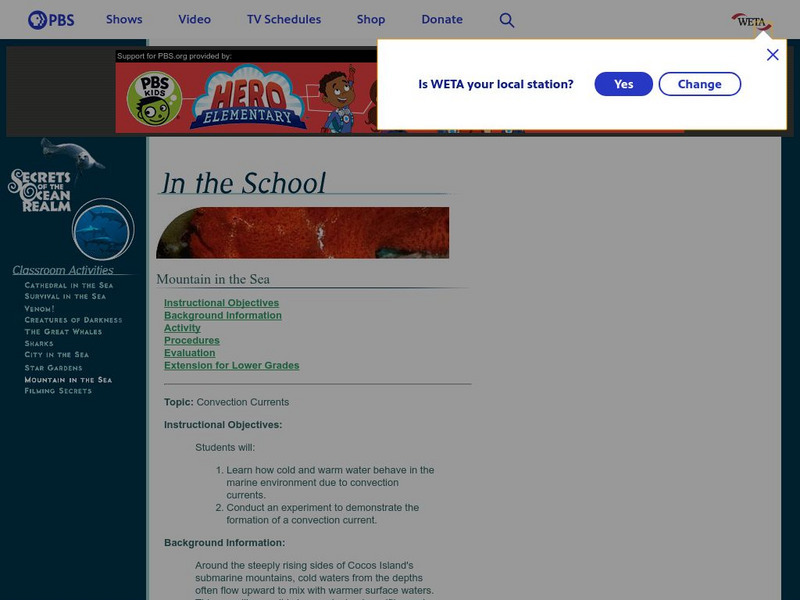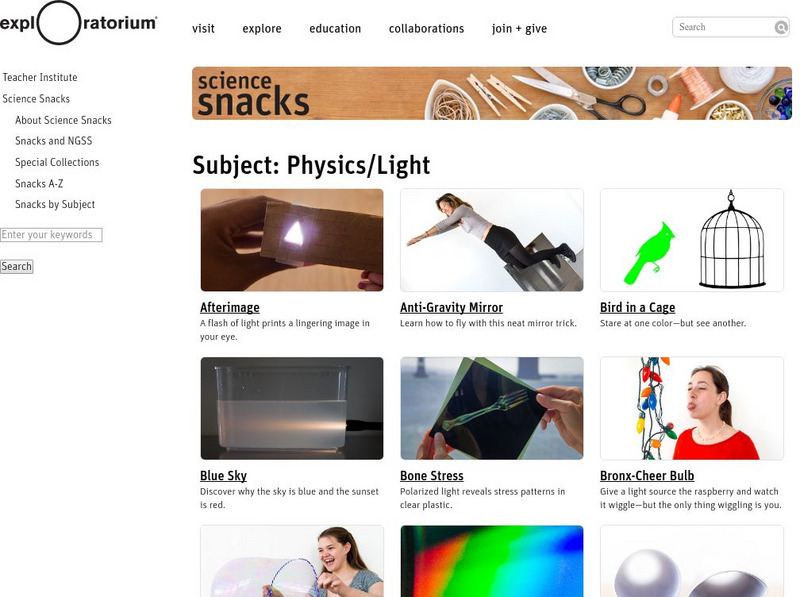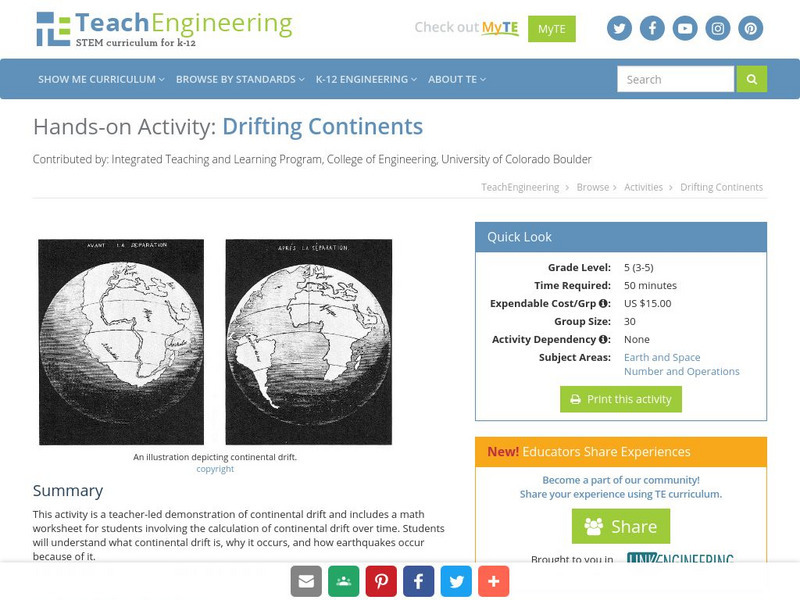Discovery Education
Motion in the Ocean
How do temperature changes affect ocean currents? Scholars explore convection currents by demonstrating the flow of water in a baking dish. They use ice, heat, and food coloring to see currents. Then, they draw conclusions about their...
Baylor College
Moving Air
In lab groups, young scientists place aluminum cans with a bubble-solution cap into different temperatures of water to see what size of bubble dome forms. As part of an atmosphere unit in preparation for learning about convection...
Curated OER
Plate Tectonics
Help young scientists piece together the theory of plate tectonics with this comprehensive collection of materials. Whether your are looking for worksheets, hands-on activities, or assessments, this resource has everything...
Museum of Science
Hot Air Balloon
It is more than just blowing hot air. Pupils first build a hot air balloon out of tissue paper by cutting enough panels of tissue paper to form a balloon shape and glue the panels together. Using a hot air gun, individuals then inflate...
University Corporation for Atmospheric Research
Ucar: Web Weather for Kids: Thunderstorms & Tornadoes Make Convection Currents
Demonstrate convection currents using a clear box, red food coloring, ice cubes, colored pencils and index cards. Get all the directions you need for this simple lab.
Exploratorium
Exploratorium: Science Snacks: Convection Current
This lesson plan is a great way to show convection currents in water. Students will see what happens to water as it gets warmed.
Exploratorium
Exploratorium: Science Snacks: Convection Currents
Get a visual of convention currents with this activity. This activity allows students to observe the currents by bending light due to cold and warm water.
PBS
Pbs Kids: Colored Water Convection
This PBS site allows users to learn more about water convection as they discover how to demonstrate the way convection currents form. A fun science project!
University Corporation for Atmospheric Research
Ucar: Atmospheric Processes: Convection
This site provides a pair of activities to demonstrate convection currents in air and water. Encourages students to view air as a fluid.
Exploratorium
Exploratorium: Science Snacks: Pie Pan Convection
In this experiment, students observe what happens when a pan of soapy, colored water is heated. They will see that convection currents cause the fluid to rise and sink in a localized convection cell.
Exploratorium
Exploratorium: Exhibit Cross Reference: Convection Currents
A description of a museum exhibit that illustrates convection and convection currents. Great idea stimulus for a student project or lab investigation.
Other
Steve Spangler Science: Denver's Brown Cloud
Learn how fluids move through our atmosphere and water. This experiment explains atmospheric convection currents (thunderstorms), the Gulf Stream, and temperature inversion. A video is included.
TeachEngineering
Teach Engineering: Turning the Air Upside Down
Students develop their understanding of air convection currents and temperature inversions by constructing and observing simple models.
Science Buddies
Science Buddies: Ocean Currents: Modeling 'Global Conveyor Belt' in Your Kitchen
Ocean currents have a profound effect on the climates of the continents, especially those regions bordering on the ocean. The Gulf Stream makes northwest Europe much more temperate than any other region at the same latitude, and the...
Museum of Science
Museum of Science and Industry: Activities: Fly a Hot Air Balloon
Step-by-step instructions, with photos, of how to construct a hot-air balloon from tissue paper, to demonstrate that heated air expands, creating a convection current. This activity requires the use of a hot air gun and is labor-intensive.
TeachEngineering
Teach Engineering: Let's Get Breezy!
Students apply an understanding of the concept of heat transfer through convection, conduction, and radiation as they use wireless temperature probes to investigate the heating capacity of different materials under heat lamps.
PBS
Pbs, Secrets of the Ocean Realm: Mountain in the Sea
This experiment allows your students to study the effect of temperature on water motion and also to create their own density driven current.
Exploratorium
Exploratorium: Science Snacks: Physics/light
Here is a large collection of simple science class activities for understanding the physics of light.
TeachEngineering
Teach Engineering: Drifting Continents
This activity is a teacher-led demonstration of continental drift and includes a math worksheet for students involving the calculation of continental drift over time. Students will understand what continental drift is, why it occurs, and...
TeachEngineering
Teach Engineering: Solar Water: Heat It Up!
Students explore energy efficiency, focusing on renewable energy, by designing and building flat-plate solar water heaters. They apply their understanding of the three forms of heat transfer (conduction, convection and radiation), as...
TeachEngineering
Teach Engineering: Mobile Forces
The application of engineering principles is explored in the creation of mobiles. As students create their own mobiles, they take into consideration the forces of gravity and convection air currents. They learn how an understanding of...
Other popular searches
- Convection Currents Mantle
- Convection Currents Weather
- Convection Currents Wind
- Convection Currents Lab
- What Is Convection Currents
- Colorful Convection Currents


















